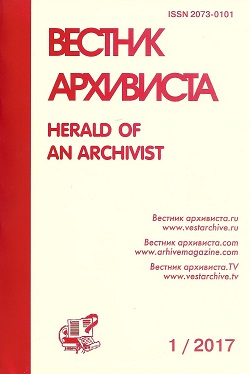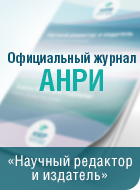Local Features of Communication Between the Soviet Government and the Cossack Population of the Kuban (1920–22): The Chronicle of Staronizhesteblievskaya Stanitsa



Scientific article
УДК 394.945+930.85+343.254+930.23+651.5+314.9+930.255 +930.253+003.074+314.8+355.01+338.23+331.1+394.94+394.942+352.93+352.07
doi 10.28995/2073-0101-2023-2-503-515
Dyukarev, Andrey V.
Krasnodar, Russian Federation
Olefir, Evgeny A.
Slavyansk-on-Kuban, Russian Federation
Local Features of Communication Between the Soviet Government and the Cossack Population of the Kuban (1920–22): The Chronicle of Staronizhesteblievskaya Stanitsa
Abstract
The article is devoted to consideration of local features of communication between the Soviet government and the Cossack population of the Kuban in 1920–22 on the example of the chronicle of life of Staronizhesteblievskaya stanitsa. Using traditional methods of system analysis, retrospective and comparative approaches to historical research, the authors have set a task of identifying mechanisms for strengthening Soviet power and organizing its interaction with the population in the Kuban villages. The Cossack population was distinguished by its conservative worldview and for most part participated in the Civil War on the side of the White movement. Identification of features of the relationship between the Soviet authorities and the Cossack population of the Kuban in the early Soviet period (1920–22) is relevant for national historical science, as it shows that repressive vector in the system of communication of victorious political forces with individual ethno-social groups and society as a whole was possible, but not mandatory. The novelty of the research lies in consideration of economic, social, and political processes occurring at the grassroots level of the South of Russia rural society, in a Cossack village. Relying on methodological provisions of microhistoric approach, according to which the objects of scientific analysis are historical events and phenomena at the local level, the authors have analyzed socially significant phenomena in the rural society of Staronizhestebliyevskaya stanitsa, revealing features of the Cossack population integration into the Soviet society. The article introduces into scientific use documents of the village revkom and higher Soviet authorities, which highlight social confrontation within the rural society. They show how the Soviet government searched for and implemented mechanisms of combating the “green” insurgency and sabotage of the prodrazverstka, using preventive arrest, confiscation of property, taking and executing hostages. Having reconstructed the chronicle of life of Staronizhesteblievskaya stanitsa in 1920–22, the authors conclude that the Soviet government set a course for confrontation with the wealthy and middle-class Cossacks in its system of communication with the Cossack population of the Kuban in the early 1920s, designing and testing a repressive model of interaction with those disagreeing with political and economic transformations. The study has been carried out on the basis of materials from the State Archive of the Krasnodar Krai. Its results can be used for comprehensive characterization of the Soviet authorities’ activities in the era of their formation and strengthening (1920–22) and of the Kuban Cossacks adaptation to the new model of state and society.
Keywords
Cossack population of the Kuban, establishment of Soviet power, prodrazverstka, “green detachments,” insurgency in the Kuban, repression, chronicle of Staronizhesteblievskaya stanitsa.
Download the article: dyukarev_olefir_doi
References
ZAITSEV, A. A. Belo-zelenoe dvizhenie na Yuge Rossii v poiskakh tret'ego puti (1920-1922 gg.) [The White-Green Movement in the South of Russia in Search of the Third Way (1920–22). In Russ.]. IN: Kul'turnaya zhizn' Yuga Rossii, 2009, no. 2 (31), pp. 62-67.
CHERKASOV, A. A. Institut zalozhnichestva na Kubani i v Chernomor'e v 1920-1922 gg. [The institute of hostage-taking in the Kuban and the Black Sea region in 1920–22]. IN: Voprosy istorii, no. 10, 2004, pp. 106-113.
YAKHUTL', Yu. A. Belo-zelenoe dvizhenie na Kubani i Chernomor'e v nachale 20-kh godov proshlogo stoletiya [The White-Green movement in the Kuban and the Black Sea region in the early 20s of the last century. In Russ.]. IN: Kul'turnaya zhizn' Yuga Rossii, 2010, no. 3 (37), pp. 49-53.
About the authors
Dyukarev Andrey Viktorovich, PhD in History, independent researcher, Krasnodar, Russian Federation, +7-960-487-67-87, This e-mail address is being protected from spambots. You need JavaScript enabled to view it
Olefir Evgeny Anatolyevich, PhD in Agriculture, JSC “Garden Giant,” head of the department of quality, storage, and commodity processing of products, Slavyansk-on-Kuban, Russian Federation, +7-928-410-14-01, This e-mail address is being protected from spambots. You need JavaScript enabled to view it
Submitted 17.01.2022, published (for citation):
DYUKAREV, A. V., OLEFIR, E. A. Lokal'nye osobennosti kommunikatsii sovetskoi vlasti i kazach'ego naseleniya Kubani v 1920-1922 gg.: khronika stanitsy Staronizhesteblievskoi [Local Features of Communication Between the Soviet Government and the Cossack Population of the Kuban (1920–22): The Chronicle of Staronizhesteblievskaya Stanitsa. In Russ.]. IN: Vestnik arhivista / Herald of an Archivist, 2023, no. 2, pp. 503-515. doi 10.28995/2073-0101-2023-2-503-515











